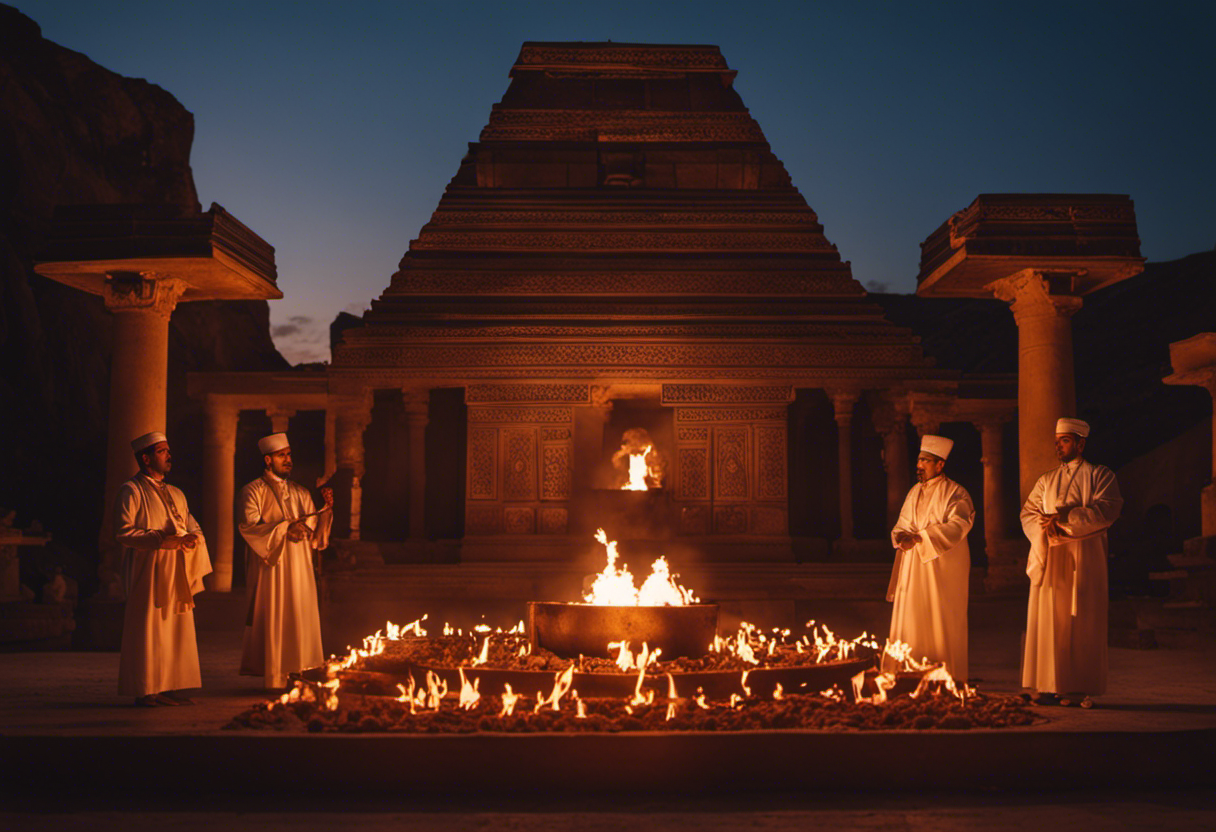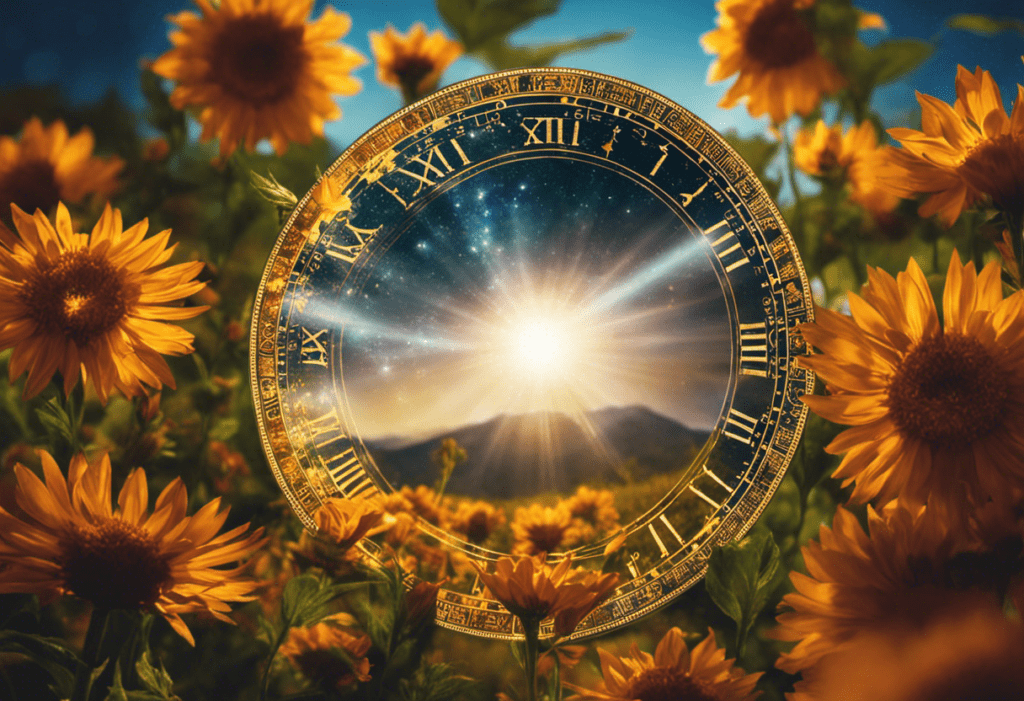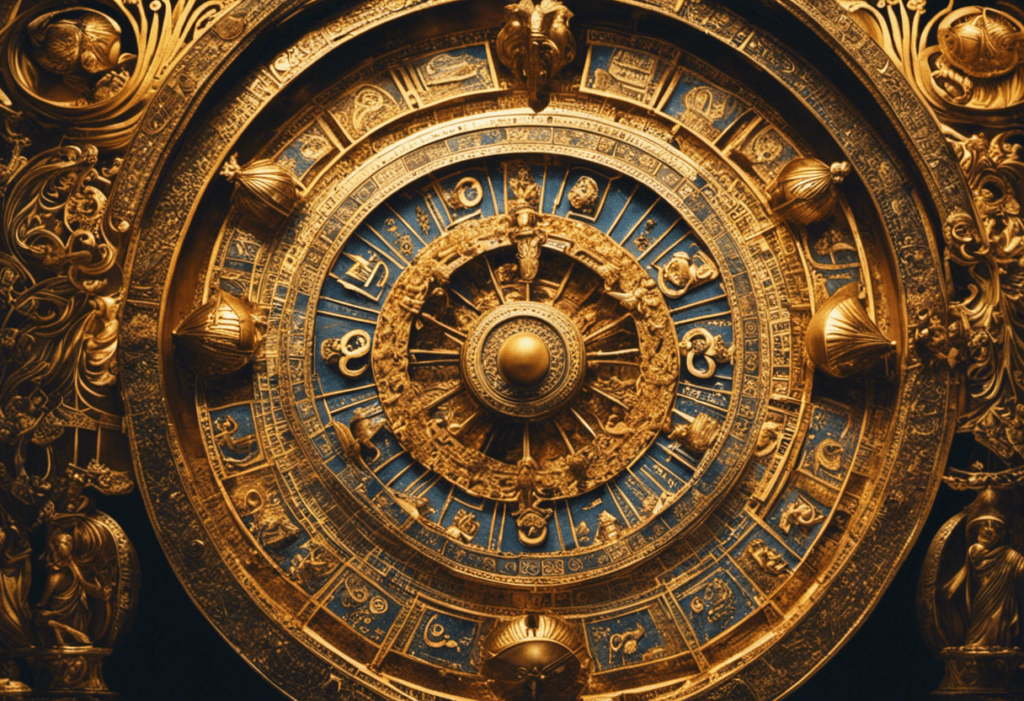In a world of diverse cultures and belief systems, the Zoroastrian calendar stands as a testament to the rich history and traditions of the ancient Persian civilization.
However, this calendar often falls prey to myths and misconceptions.
In this article, we delve into the origins of the Zoroastrian calendar, debunk common misconceptions about Zoroastrian festivals, explore the role of astrology, and shed light on the influence of this calendar on modern society.
Join us as we unravel the truth behind the Zoroastrian calendar.
Key Takeaways
- The Zoroastrian calendar originated in ancient Persia and was developed based on the teachings of the prophet Zoroaster. It initially consisted of 12 months of 30 days each, with five additional days added at the end of the year. Over time, it underwent changes and advancements to ensure greater accuracy.
- Zoroastrian festivals serve as an opportunity for community building and social interaction, attracting people from different religious backgrounds. These festivals have evolved over time while maintaining core principles and values, and they are celebrated by both Zoroastrians and non-Zoroastrians alike.
- Astrology plays a significant role in the Zoroastrian calendar, determining auspicious times for rituals and ceremonies. The calendar is linked to celestial events, seasonal changes, astrological signs, and festivals. The astrological significance of dates allows for a deeper interpretation and appreciation of rituals.
- The Zoroastrian calendar has a unique relationship with celestial bodies and has deeply influenced astrology and our understanding of celestial events. Despite historical challenges and the spread of Islam, the Zoroastrian calendar and its astrological practices have endured and continue to shape horoscopes and religious practices.
Origins of the Zoroastrian Calendar


One of the key questions surrounding the Origins of the Zoroastrian Calendar is the exact number of millennia that have passed since its inception. The Zoroastrian calendar, also known as the Parsi calendar, is believed to have originated in ancient Persia around the 6th century BCE. Its development can be traced back to the teachings of the prophet Zoroaster, who founded the religion of Zoroastrianism.
The origins of the Zoroastrian calendar can be seen as a result of the religious and cultural developments that took place in ancient Persia. Zoroastrianism, with its emphasis on the worship of a supreme deity and the battle between good and evil, played a significant role in shaping the calendar. It was designed to align with the religious rituals and observances of Zoroastrianism.
The Zoroastrian calendar underwent several changes and developments over time. The earliest version of the calendar consisted of 12 months of 30 days each, with five additional days added at the end of the year to maintain alignment with the solar year. However, as astronomical knowledge advanced, adjustments were made to ensure greater accuracy.
Common Misconceptions About Zoroastrian Festivals


Interestingly, there are several common misconceptions about Zoroastrian festivals, but they can be easily debunked with a closer examination of the religion’s practices and beliefs.
Zoroastrian festival traditions hold a significant cultural significance for followers of the faith. One common misconception is that Zoroastrian festivals are solely religious in nature. While they do have a religious component, these festivals also serve as an opportunity for community building and social interaction. They provide a platform for Zoroastrians to come together, share their experiences, and reinforce their sense of identity as a community.
Another misconception is that Zoroastrian festivals are only celebrated by Zoroastrians. In fact, these festivals often attract people from different religious backgrounds who are interested in learning more about the Zoroastrian faith and its traditions. This interfaith participation fosters understanding and promotes religious tolerance.
Furthermore, it is crucial to note that Zoroastrian festivals are not static rituals but have evolved over time. They have adapted to the changing needs and circumstances of the community, while still maintaining their core principles and values.
The Role of Astrology in the Zoroastrian Calendar


Astrology plays a significant role in the Zoroastrian calendar, with specific dates and events being determined by astrological significance.
The Zoroastrians believe that celestial bodies have a profound influence on human lives and events, and therefore, astrology is used to determine auspicious times for various rituals and ceremonies.
The historical influence of astrology on the Zoroastrian calendar highlights the deep interconnection between celestial movements and religious practices in this ancient faith.
Astrological Significance of Dates
The significance of dates in the Zoroastrian Calendar can be attributed to the alignment of celestial bodies and their influence on human affairs. The calendar is deeply rooted in astrology, and each date holds a special meaning and interpretation.
Here are four key aspects of the astrological significance of dates in the Zoroastrian Calendar:
-
Celestial Events: The dates in the calendar are often linked to celestial events such as equinoxes, solstices, and planetary alignments. These events are believed to have a profound impact on human life and are carefully observed and interpreted.
-
Seasonal Changes: The calendar marks the changing seasons, which play a crucial role in agricultural practices and religious ceremonies. Each date signifies the transition from one season to another, influencing farming activities and spiritual rituals.
-
Astrological Signs: The dates in the calendar are associated with specific zodiac signs, providing insight into individual characteristics and personality traits. These interpretations help individuals understand themselves better and navigate their lives accordingly.
-
Festivals and Celebrations: Many festivals and celebrations in the Zoroastrian tradition are held on specific dates in the calendar. These dates are chosen based on their astrological significance, ensuring the alignment of cosmic energies with the purpose of the event.
Understanding the astrological significance of dates in the Zoroastrian Calendar allows individuals to interpret and appreciate the deeper meanings behind their rituals and observances.
Historical Influence on Astrology
One cannot underestimate the profound impact that historical events and cultural traditions have had on shaping the astrological practices found within the Zoroastrian Calendar.
The Zoroastrian Calendar, also known as the Iranian Calendar, is deeply rooted in ancient Persian culture and religion. This calendar has a unique relationship with celestial bodies, as it is based on the movement of the Sun and Moon.
Historical events such as the Arab conquest of Persia and the subsequent spread of Islam led to the decline of Zoroastrianism and the suppression of its astrological practices. However, despite the challenges faced, the Zoroastrian Calendar continues to hold significance for many practitioners today.
Its influence on horoscopes and the understanding of celestial events in the context of Zoroastrianism is a testament to the enduring legacy of this ancient tradition.
Understanding the Zoroastrian New Year: Nowruz


Celebrating the arrival of spring, Nowruz is an ancient Zoroastrian festival that symbolizes rebirth and renewal. This vibrant cultural celebration, observed by millions of people around the world, is a time of joy, hope, and reflection.
As part of the Nowruz celebrations, various traditional customs are practiced, each holding its significance and adding to the richness of the festival. Here are four key customs associated with Nowruz:
-
Haft-Seen: One of the most important elements of Nowruz is the Haft-Seen table. This elaborate display consists of seven items, each starting with the Persian letter ‘seen.’ These items represent different aspects of life and include Sabzeh (sprouted wheat or lentils), Senjed (dried fruit), and Seer (garlic).
-
Chaharshanbe Suri: On the eve of the last Wednesday before Nowruz, Iranians celebrate Chaharshanbe Suri, also known as the Festival of Fire. People jump over bonfires while reciting a traditional phrase, symbolizing the burning away of negativity and welcoming a fresh start.
-
Visiting Family and Friends: Nowruz is a time for gathering with loved ones. People visit each other’s homes, exchange gifts, and share festive meals. This tradition strengthens social bonds and promotes unity.
-
Sizdah Bedar: On the thirteenth day of Nowruz, families head outdoors for a picnic. It is believed that spending this day in nature brings good luck and ensures a prosperous year ahead.
Nowruz celebrations and traditional customs play a significant role in preserving Zoroastrian culture and fostering a sense of community. As this ancient festival continues to be celebrated, it serves as a reminder of the enduring power of tradition and the importance of renewal in our lives.
Dispelling Myths About Zoroastrian Rituals and Practices


Zoroastrian rituals and practices are often misunderstood due to various myths and misconceptions. By examining the ritual symbolism and debunking common misconceptions, we can gain a clearer understanding of these important aspects of the Zoroastrian faith.
It is crucial to approach the discussion with objectivity and analytical thinking to dispel any false beliefs surrounding Zoroastrian rituals and practices.
Ritual Symbolism Clarified
The Zoroastrian scholars meticulously analyze and expound upon the intricate layers of ritual symbolism, shedding light on the true essence and significance of Zoroastrian rituals and practices. Through their research and interpretation, they have clarified several aspects of ritual symbolism, providing a deeper understanding of the religion.
Here are four key points that have been discussed regarding the explanation and significance of Zoroastrian ritual symbolism:
-
Fire: Fire is a central symbol in Zoroastrianism, representing purity, light, and the presence of divinity. The rituals involving fire are meant to invoke spiritual transformation and purify the individual.
-
Prayers: Zoroastrian rituals often involve reciting prayers, which serve as a means of communication with the divine. These prayers express devotion, gratitude, and seek guidance and protection.
-
Rituals of purification: Various purification rituals are performed to cleanse the body, mind, and soul. These rituals aim to remove impurities and negative influences, allowing individuals to connect with the divine and attain spiritual purity.
-
Festivals and celebrations: Zoroastrian festivals and celebrations are not merely social gatherings, but rather occasions to commemorate important events, honor deities, and strengthen community bonds. These rituals serve to reinforce the religious identity and values of the community.
Common Misconceptions Debunked
While some misconceptions about Zoroastrian rituals and practices persist, scholars have diligently debunked these myths and provided accurate insights into the true nature of the religion.
Zoroastrianism, one of the oldest known religions, has often been misunderstood due to its complex rituals and unique beliefs. One of the most common misunderstood beliefs is the association of Zoroastrians with fire worship. While fire holds great cultural significance in Zoroastrianism, it is not worshipped as a deity but rather seen as a symbol of purity and divinity.
Another misunderstood belief is that Zoroastrians are solely focused on the afterlife and neglect worldly matters. In reality, Zoroastrians emphasize the importance of leading a righteous and ethical life, with an understanding that individual actions have consequences in this life as well as the next.
The Influence of the Zoroastrian Calendar on Modern Society


Incorporating the Zoroastrian calendar into contemporary societies enables individuals to commemorate significant events and plan their activities with precision. The Zoroastrian calendar, also known as the Shahanshahi calendar, has a rich history and holds great cultural significance for the Zoroastrian community. This ancient calendar system continues to influence religious practices and cultural events in various ways.
Here are four ways in which the Zoroastrian calendar influences modern society:
-
Religious Festivals: The Zoroastrian calendar determines the dates of religious festivals such as Nowruz, the New Year celebration, and Mehregan, the festival of harvest. These festivals play a crucial role in maintaining religious traditions and fostering a sense of community among Zoroastrians.
-
Astrological Significance: The Zoroastrian calendar is based on the movements of celestial bodies, particularly the sun and moon. This astrological significance influences the timing of rituals and ceremonies, ensuring that they align with cosmic energies and spiritual beliefs.
-
Ritual Observances: The Zoroastrian calendar guides the timing of various ritual observances, such as the performance of prayers and the observance of fasting periods. By following the calendar, individuals can observe religious practices in accordance with their faith.
-
Cultural Identity: The Zoroastrian calendar serves as a marker of cultural identity for the Zoroastrian community. It helps preserve their ancient traditions, customs, and beliefs, reinforcing their sense of belonging and heritage.
Conclusion
In conclusion, the Zoroastrian calendar holds great significance in the religious and cultural practices of the Zoroastrian community. Its origins, festivals, and rituals are often misunderstood and surrounded by myths.
Astrology plays a crucial role in determining the dates of celebrations, while Nowruz, the Zoroastrian New Year, is a time of renewal and celebration.
By dispelling misconceptions and understanding the true essence of Zoroastrianism, we can appreciate the impact of this ancient calendar on modern society.



